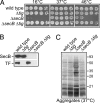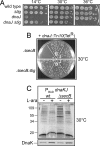Trigger Factor can antagonize both SecB and DnaK/DnaJ chaperone functions in Escherichia coli
- PMID: 17360615
- PMCID: PMC1805596
- DOI: 10.1073/pnas.0608232104
Trigger Factor can antagonize both SecB and DnaK/DnaJ chaperone functions in Escherichia coli
Abstract
Polypeptides emerging from the ribosome are assisted by a pool of molecular chaperones and targeting factors, which enable them to efficiently partition as cytoplasmic, integral membrane, or exported proteins. In Escherichia coli, the chaperones SecB, Trigger Factor (TF), and DnaK are key players in this process. Here, we report that, as with dnaK or dnaJ mutants, a secB null strain exhibits a strong cold-sensitive (Cs) phenotype. Through suppressor analyses, we found that inactivating mutations in the tig gene encoding TF fully relieve both the Cs phenotype and protein aggregation observed in the absence of SecB. This antagonistic effect of TF depends on its ribosome-binding and chaperone activities but unrelated to its peptidyl-prolyl cis/trans isomerase (PPIase) activity. Furthermore, in contrast to the previously known synergistic action of TF and DnaK/DnaJ above 30 degrees C, a tig null mutation partially suppresses the Cs phenotype exhibited by a compromised DnaK/DnaJ chaperone machine. The antagonistic role of TF is further exemplified by the fact that the secB dnaJ double mutant is viable only in the absence of TF. Finally, we show that, in the absence of TF, more SecA and ribosomes are associated with the inner membrane, suggesting that the presence of TF directly or indirectly interferes with the process of cotranslational protein targeting to the Sec translocon.
Conflict of interest statement
The authors declare no conflict of interest.
Figures





Similar articles
-
SecB is a bona fide generalized chaperone in Escherichia coli.Proc Natl Acad Sci U S A. 2004 May 18;101(20):7583-8. doi: 10.1073/pnas.0402398101. Epub 2004 May 5. Proc Natl Acad Sci U S A. 2004. PMID: 15128935 Free PMC article.
-
Functional dissection of Escherichia coli trigger factor: unraveling the function of individual domains.J Bacteriol. 2004 Jun;186(12):3777-84. doi: 10.1128/JB.186.12.3777-3784.2004. J Bacteriol. 2004. PMID: 15175291 Free PMC article.
-
Evaluation of similarities in the cis/trans isomerase function of trigger factor and DnaK.Biol Chem. 2002 Dec;383(12):1865-73. doi: 10.1515/BC.2002.210. Biol Chem. 2002. PMID: 12553723
-
Chaperone networking facilitates protein targeting to the bacterial cytoplasmic membrane.Biochim Biophys Acta. 2014 Aug;1843(8):1442-56. doi: 10.1016/j.bbamcr.2013.11.007. Epub 2013 Nov 21. Biochim Biophys Acta. 2014. PMID: 24269840 Review.
-
The Hsp70 chaperone machines of Escherichia coli: a paradigm for the repartition of chaperone functions.Mol Microbiol. 2007 Nov;66(4):840-57. doi: 10.1111/j.1365-2958.2007.05961.x. Epub 2007 Oct 4. Mol Microbiol. 2007. PMID: 17919282 Review.
Cited by
-
How Quality Control Systems AID Sec-Dependent Protein Translocation.Front Mol Biosci. 2021 Apr 13;8:669376. doi: 10.3389/fmolb.2021.669376. eCollection 2021. Front Mol Biosci. 2021. PMID: 33928127 Free PMC article. Review.
-
SecA Cotranslationally Interacts with Nascent Substrate Proteins In Vivo.J Bacteriol. 2016 Dec 28;199(2):e00622-16. doi: 10.1128/JB.00622-16. Print 2017 Jan 15. J Bacteriol. 2016. PMID: 27795329 Free PMC article.
-
Structural insights into chaperone addiction of toxin-antitoxin systems.Nat Commun. 2019 Feb 15;10(1):782. doi: 10.1038/s41467-019-08747-4. Nat Commun. 2019. PMID: 30770830 Free PMC article.
-
Multitasking SecB chaperones in bacteria.Front Microbiol. 2014 Dec 5;5:666. doi: 10.3389/fmicb.2014.00666. eCollection 2014. Front Microbiol. 2014. PMID: 25538690 Free PMC article. Review.
-
Oligomerization of a molecular chaperone modulates its activity.Elife. 2018 May 1;7:e35731. doi: 10.7554/eLife.35731. Elife. 2018. PMID: 29714686 Free PMC article.
References
-
- Bukau B, Deuerling E, Pfund C, Craig EA. Cell. 2000;101:119–122. - PubMed
-
- Young JC, Agashe VR, Siegers K, Hartl FU. Nat Rev Mol Cell Biol. 2004;5:781–791. - PubMed
-
- Lill R, Crooke E, Guthrie B, Wickner W. Cell. 1988;54:1013–1018. - PubMed
-
- Luirink J, Sinning I. Biochim Biophys Acta. 2004;1694:17–35. - PubMed
-
- Veenendaal AK, van der Does C, Driessen AJ. Biochim Biophys Acta. 2004;1694:81–95. - PubMed
Publication types
MeSH terms
Substances
LinkOut - more resources
Full Text Sources
Molecular Biology Databases
Miscellaneous

